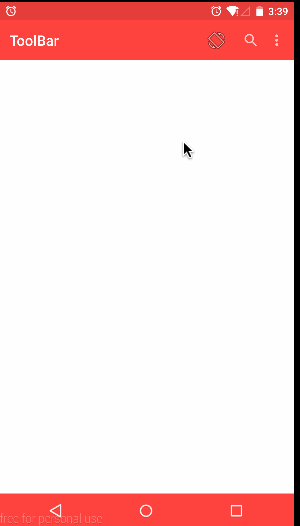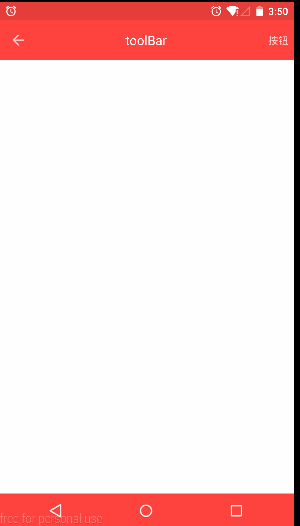Friends who have used ToolBar must be familiar with its usage, because its usage is very simple. If you are skilled in using ActionBar, ToolBar will be easier! However, I believe that you have encountered such a problem in the process of using, we need to add ToolBar control to every xml we want to use. For example, if I need to use ToolBar in MainActivity, then his xml file needs to be written like this.
<RelativeLayout xmlns:android="http://schemas.android.com/apk/res/android"
xmlns:tools="http://schemas.android.com/tools"
xmlns:app="http://schemas.android.com/apk/res-auto"
android:layout_width="match_parent"
android:layout_height="match_parent"
android:background="@android:color/white">
<android.support.v7.widget.Toolbar
android:layout_height="?attr/actionBarSize"
android:layout_width="match_parent"
android:id="@+id/id_tool_bar"
android:background="?attr/colorPrimary"
app:navigationIcon="?attr/homeAsUpIndicator"
>
</android.support.v7.widget.Toolbar>
<TextView
android:text="@string/hello_world"
android:layout_width="wrap_content"
android:layout_height="wrap_content"/>
<TextView
android:layout_width="wrap_content"
android:layout_height="wrap_content"
android:text="asdfasf"
android:layout_alignParentBottom="true"/>
</RelativeLayout>
Similarly, pages needed in other activities need to be added in xml
<android.support.v7.widget.Toolbar
android:layout_height="?attr/actionBarSize"
android:layout_width="match_parent"
android:id="@+id/id_tool_bar"
android:background="?attr/colorPrimary"
app:navigationIcon="?attr/homeAsUpIndicator"
>
</android.support.v7.widget.Toolbar>Such a piece of code, although not many, but our most troublesome is to write duplicate code, also does not conform to our programming ideas; so there are the following writing methods
<RelativeLayout xmlns:android="http://schemas.android.com/apk/res/android"
android:layout_width="match_parent"
android:layout_height="match_parent"
android:background="@android:color/white">
<include layout="@layout/toolbar"
android:layout_width="match_parent"
android:layout_height="?attr/actionBarSize"
/>
<TextView
android:text="@string/hello_world"
android:layout_width="wrap_content"
android:layout_height="wrap_content"/>
<TextView
android:layout_width="wrap_content"
android:layout_height="wrap_content"
android:text="asdfasf"
android:layout_alignParentBottom="true"/>
</RelativeLayout>
The code for toolbar.xml is as follows
<?xml version="1.0" encoding="utf-8"?>
<FrameLayout xmlns:android="http://schemas.android.com/apk/res/android"
xmlns:app="http://schemas.android.com/apk/res-auto"
android:layout_width="match_parent"
android:layout_height="match_parent">
<android.support.v7.widget.Toolbar
android:layout_height="?attr/actionBarSize"
android:layout_width="match_parent"
android:id="@+id/id_tool_bar"
android:background="?attr/colorPrimary"
app:navigationIcon="?attr/homeAsUpIndicator"
>
</android.support.v7.widget.Toolbar>
</FrameLayout>
So we just need to embed the toolbar.xml layout in every XML we want to use toolbar through include. It feels like a few lines less code than before! But it doesn't make much sense. And the encapsulation that I want to achieve here is that I don't need to write a line of code about toolbar in xml, that is to say, I don't need to write toolbar in the same way as usual. Look down, please.
The premise is to prepare toolbar.xml,ToolBarActivity.java,ToolBarHelper.java
The basic attributes of configuring toolbar in toolbar.xml are:
Other styles such as the width of toolbar, the background color of toolbar, etc.
ToolBarActivity.java is the parent class of toolbar Activity, which I define as an abstract class because a single class can't do anything.
ToolBarHelper.java is an association class between Activity and toolbar
Let's start with the toolbar.xml code
<?xml version="1.0" encoding="utf-8"?>
<FrameLayout xmlns:android="http://schemas.android.com/apk/res/android"
xmlns:app="http://schemas.android.com/apk/res-auto"
android:layout_width="match_parent"
android:layout_height="match_parent">
<android.support.v7.widget.Toolbar
Set the height to ActionBar Height
android:layout_height="?attr/actionBarSize"
android:layout_width="match_parent"
android:id="@+id/id_tool_bar"
//The background color is ActionBar Background color
android:background="?attr/colorPrimary"
//Return button icon
app:navigationIcon="?attr/homeAsUpIndicator"
>
</android.support.v7.widget.Toolbar>
</FrameLayout>Content of ToolBarActivity.java: The main code is implemented in setContentView (int id)
package toolbar.toolbar;
import android.os.Bundle;
import android.support.v7.app.AppCompatActivity;
import android.support.v7.widget.Toolbar;
import android.view.MenuItem;
/**
* Created by moon.zhong on 2015/6/12.
* time : 10:26
*/
public abstract class ToolBarActivity extends AppCompatActivity {
private ToolBarHelper mToolBarHelper ;
public Toolbar toolbar ;
@Override
protected void onCreate(Bundle savedInstanceState) {
super.onCreate(savedInstanceState);
}
@Override
public void setContentView(int layoutResID) {
mToolBarHelper = new ToolBarHelper(this,layoutResID) ;
toolbar = mToolBarHelper.getToolBar() ;
setContentView(mToolBarHelper.getContentView());
/*Set toolbar to Activity*/
setSupportActionBar(toolbar);
/*Some custom operations*/
onCreateCustomToolBar(toolbar) ;
}
public void onCreateCustomToolBar(Toolbar toolbar){
toolbar.setContentInsetsRelative(0,0);
}
@Override
public boolean onOptionsItemSelected(MenuItem item) {
if (item.getItemId() == android.R.id.home){
finish();
return true ;
}
return super.onOptionsItemSelected(item);
}
}
ToolBarHelper.java
The function of this class is to create a ViewGroup as the parent view of the view, and Add the user-defined View and toolBar to the ViewGroup in turn.
package toolbar.toolbar;
import android.content.Context;
import android.content.res.TypedArray;
import android.support.v7.widget.Toolbar;
import android.view.LayoutInflater;
import android.view.View;
import android.view.ViewGroup;
import android.widget.FrameLayout;
/**
* Created by moon.zhong on 2015/6/12.
* time : 10:45
*/
public class ToolBarHelper {
/*Context, which you need to use when creating a view*/
private Context mContext;
/*base view*/
private FrameLayout mContentView;
/*User-defined view*/
private View mUserView;
/*toolbar*/
private Toolbar mToolBar;
/*View constructor*/
private LayoutInflater mInflater;
/*
* Two properties
* 1,toolbar Is it suspended above the window?
* 2,toolbar High Acquisition
* */
private static int[] ATTRS = {
R.attr.windowActionBarOverlay,
R.attr.actionBarSize
};
public ToolBarHelper(Context context, int layoutId) {
this.mContext = context;
mInflater = LayoutInflater.from(mContext);
/*Initialize the whole content*/
initContentView();
/*Initialize user-defined layout*/
initUserView(layoutId);
/*Initialize toolbar*/
initToolBar();
}
private void initContentView() {
/*Create a frame layout directly as the parent container of the view container*/
mContentView = new FrameLayout(mContext);
ViewGroup.LayoutParams params = new ViewGroup.LayoutParams(ViewGroup.LayoutParams.MATCH_PARENT,
ViewGroup.LayoutParams.MATCH_PARENT);
mContentView.setLayoutParams(params);
}
private void initToolBar() {
/*Getting the layout file of toolbar through inflater*/
View toolbar = mInflater.inflate(R.layout.toolbar, mContentView);
mToolBar = (Toolbar) toolbar.findViewById(R.id.id_tool_bar);
}
private void initUserView(int id) {
mUserView = mInflater.inflate(id, null);
FrameLayout.LayoutParams params = new FrameLayout.LayoutParams(ViewGroup.LayoutParams.MATCH_PARENT, ViewGroup.LayoutParams.MATCH_PARENT);
TypedArray typedArray = mContext.getTheme().obtainStyledAttributes(ATTRS);
/*Get the suspension flag defined in the topic*/
boolean overly = typedArray.getBoolean(0, false);
/*Get the height of the toolbar defined in the topic*/
int toolBarSize = (int) typedArray.getDimension(1,(int) mContext.getResources().getDimension(R.dimen.abc_action_bar_default_height_material));
typedArray.recycle();
/*If it is suspended, there is no need to set spacing.*/
params.topMargin = overly ? 0 : toolBarSize;
mContentView.addView(mUserView, params);
}
public FrameLayout getContentView() {
return mContentView;
}
public Toolbar getToolBar() {
return mToolBar;
}
}
Here, even if the simple package of toolbar is finished, let's take a look at the effect of the package.
MainActivity.java
package toolbar.toolbar;
import android.os.Bundle;
import android.support.v7.widget.Toolbar;
import android.view.Menu;
import android.view.MenuItem;
public class MainActivity extends ToolBarActivity {
@Override
protected void onCreate(Bundle savedInstanceState) {
super.onCreate(savedInstanceState);
setContentView(R.layout.activity_main);
}
@Override
public boolean onCreateOptionsMenu(Menu menu) {
// Inflate the menu; this adds items to the action bar if it is present.
getMenuInflater().inflate(R.menu.menu_main, menu);
return true;
}
}
activity_main.xml
<RelativeLayout xmlns:android="http://schemas.android.com/apk/res/android"
android:layout_width="match_parent"
android:layout_height="match_parent"
android:background="@android:color/white">
<TextView
android:text="@string/hello_world"
android:layout_width="wrap_content"
android:layout_height="wrap_content"/>
<TextView
android:layout_width="wrap_content"
android:layout_height="wrap_content"
android:text="asdfasf"
android:layout_alignParentBottom="true"/>
</RelativeLayout>
There is no ToolBar in MainActivity or activity_main, but MainActivity no longer inherits AppCompatActivity, but inherits our ToolBar Activity.
The other uses of ToolBar are not mentioned here. They are almost the same as ActionBar.
Finally:
When using ToolBar, you need to use an ActionBar-free theme.
<!-- Base application theme. -->
<style name="AppThemeParent" parent="Theme.AppCompat.NoActionBar">
<!-- Customize your theme here. -->
<item name="colorPrimary">@android:color/holo_red_light</item>
</style>
Another ToolBar rendering of a custom View:
The title is in the middle, and buttons can be added to the right.
Source download